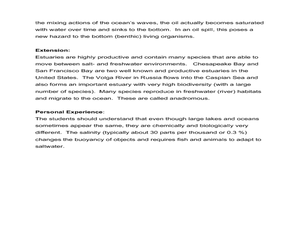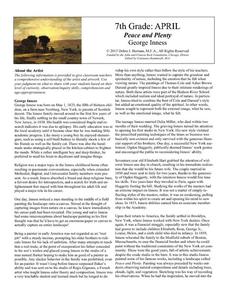Curated OER
Memory Book - A Cooperative Learning Experience
Students document sections of their life through pictures, stories, and video to create an English "memory book". They use photographs, video and edited video which includes their history, includes calculated growth, and genetic...
Curated OER
Life of Thomas Edison
Students research the life of Thomas Edison. In this Thomas Edison lesson, students explore major life events of Thomas Edison. Students investigate the inventions of Thomas Edison. Students discover how various fields of study...
Curated OER
Math & Science
Young scholars examine a list of ideas to draw from for lesson planning. They complete a quiz on Math & Science and hand in notes they have taken as a resource for lesson planning. They develop developmental appropriate practice...
Curated OER
Teacher's Guide For: Water Temperature and Salinity Experiment
Students experiment with water density, temperature and salinity. In this water lesson, students observe how the coldest water sinks to the bottom of a test tube, and how saltwater sinks in comparison to freshwater.
Curated OER
Adding Creativity to Science Inquiry
Middle schoolers investigate friction by manipulating some of the variables affecting it. For this inquiry lesson, students design their own experiment. They create a video about it and share it to class.
Curated OER
Come Shine with Us: Floor Polish Testing and Industrial Science To Teach Critical Thinking
Middle schoolers discover that science relates to everyday life and see testing procedures used in an industrial laboratory. Students compare various brands of household and industrial floor polishes for specific criteria.
Curated OER
Earth & Space Science: Holding it Together
Students estimate how many drops of water can fit onto the surface of a penny and then test their hypothesis to find out. They also experiment with bubbles.
Curated OER
Odyssey of Life, Part II-The Unknown World
Students complete an experiment in which they observe different natural sample in which they uncover the microbial world. They complete a two part worksheet that accompanies the lesson plan.
Virginia Polytechnic Institute and State University
Lesson Plan: Omelet Cooking Principles
Although designed for a foods lab, the information in this resource might be just the thing for your own recipe notebook. Illustrated, step-by-step directions for making the perfect omelet, egg-citing puzzles, games, and even...
California Department of Education
Possible Careers
Is a STEM career the right choice for me? Lesson four in a six-part career and college readiness series introduces seventh graders to the world of STEM occupations. Individuals use their Holland code results to select, research, and...
American Museum of Natural History
Finding Fossils
How does one go about finding fossils? Find out with an informative webpage that looks at the digging process, showcases rocks and common fossils, helpful tips, and a list of archeological do's and don'ts.
Concordia University Chicago
Peace and Plenty by George Inness
Learners will need to discuss the Civil War to truly understand the painting Peace and Plenty by George Inness. They'll analyze the painting in terms of context, style, and technique. Then, they'll experiment with light and composition...
American Museum of Natural History
Buried Bones
Patience is the name of the game. Using Plaster of Paris and chicken bones, learners simulate an archeological dig site. They excavate the chicken bones over a period of several days using tools and a large amount of patience.
Workforce Solutions
Workforce Solutions Pre-K Lessons
Four lessons, each following the same routine, explore the careers of a teacher, nurse, electrician, geologist, plumber, and police officer. After listening to a read-aloud and thoughtful discussion, young scholars construct puppets...
Curated OER
Cruzin' to the Arctic
Students, in groups, study life in the Arctic Region and connect their own life experiences to the experiences of students in the Arctic.
Curated OER
Water
Students conduct a series of investigations on the unique properties of water. In this general science lesson, students explain what causes water's surface tension. They explain the different stages in the water cycle.
Curated OER
Oil Spill in a Test Tube
Students develop a test tube model of an oil spill in order to experiment with conditions needed for bioremediation. They apply the principals of experimental design by analyzing a research article on the EXXON Valdez bioremediation...
Curated OER
What is the Attraction?
Second graders investigate the law of polarity. For this magnets lesson, 2nd graders discover how magnets are used in everyday life and which objects in our environment are magnetic. Students experiment with bar magnets and record...
Curated OER
Water Cycle
Learners identify the different stages in the water cycle. In this earth science lesson, students calculate the residence time of water in oceans using a mathematical formula. They explain how this cycle regulates the Earth's climate.
Curated OER
Photosynthesis
High schoolers conduct a variety of experiments on photosynthesis. In this biology instructional activity, students identify the factors required for the process to occur. They perform computerized experiments to test the amount of...
Curated OER
Student Internship Program
Students research and identify their own internship opportunities. They keep a daily journal describing their experiences during their 30 hour volunteer internship programs
Curated OER
Chemiluminescence
Students explore chemiluminescence through various experiments. In this chemistry lesson, students explain the chemical reaction that drives the process. They give real life applications of chemiluminescence.
Curated OER
Change or Adaptation
Students identify the adaptive forces in the life cycle of plants, animals, and humans, isolate and identify the role that change and adaptation play in extreme environments and research and write a short term paper using MLA citations.
Curated OER
The Discovery of Photosynthesis
Students explore how scientists discover photosynthesis. In this biology lesson, students identify the basic requirements for photosynthesis to happen. They recreate past scientists' experiments and record their observations.

























